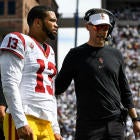It's incredible to think about how much college football has changed in this decade alone. I first began covering college football here at CBS Sports for the 2010 season, and looking back on the sport then, some parts are nearly unrecognizable.
First of all, there were only 120 FBS teams. When the 2019 season begins, we'll be at 130. Of those 120 teams, only 10 were in the Pac-12, 11 in the Big Ten, and the SEC and ACC were only at 12 teams. The Big East still existed and had eight teams. The Mountain West had nine teams, and if you think having nine teams in your conference is weird, it was one of three nine-team conferences at the time. The Sun Belt and the WAC (RIP) were the other two.
Going back and looking at the standings from the 2010 season is a lot like going to a history museum and seeing how the world was in the time of the dinosaurs, except, you know, it was only nine years ago.
The land of college football before conference realignment seems like a peaceful place, but the meteor that was television revenue was barreling down on the planet whether they realized it or not at the time. OK, I'm pushing the metaphor too hard now, but you get the point.
Not only were there 120 FBS teams, and conferences like the WAC and the Big East still existed, but Maryland was in the ACC. Nebraska, Colorado and Missouri were in the Big 12 North, while Texas A&M was in the Big 12 South. West Virginia, Pitt, Syracuse, Louisville and Rutgers were in the Big East. TCU and Utah were in the Mountain West. Clemson went 6-7 in the second year under some guy named Dabo Swinney, who almost definitely wasn't going to get through Year Three. UCF went 11-3, but nobody claimed a national title or said it should be playing for a BCS Championship Game.
It was a simpler time, people.
I began thinking about all of this because a number of you sent me questions this week that all centered around the same principle theme: What does the future of college football realignment look like?
It's hard to know for sure. Again, look at how much has changed in this decade. Trying to predict what will happen in the future seems foolish, but while I don't know what exactly it will look like, I can say I don't believe conference realignment is over. Things are going to change again; the question is what will those changes look like?
Ideally, the scenario I'd most like to see would be one that I proposed a few years ago that adopts the European soccer model of promotion and relegation. One that I can damn near guarantee you would never happen, but it would be fun if it did.
The truth is, the most likely scenario of realignment won't look like the realignment we saw this decade. It's not going to be Power Five conference plucking schools from Group of Five conferences to bolster television markets for their conference networks. We're heading toward an era where streaming television will eventually be the norm, and cable will become an antiquated way of consuming TV. So, while the size of your fan base will matter, your geographic footprint won't. Like Netflix or Hulu, your viewership will be subscriber based. No poor sucker in New York City who doesn't give even the slightest damn about college football will be forced to shell out $1.40 a month on his cable bill because Comcast picked up the Big Ten Network in the area because Rutgers joined the conference.
I see a scenario in which the Power Five conferences permanently break off from the NCAA and the Group of Five schools and form their own new league. Whether it will be professional, semi-professional, or the same charade we currently have, I can't say. Perhaps they snag a few of the bigger Group of Five schools to join them before leaving, but I think the most significant part of conference realignment will be that the conferences themselves disappear in a way. They'll still exist, but not in the same manner as we have them in college football. It'll be more like the way both the Seattle Seahawks and New York Giants share the same conference in the NFL.
While a four-team playoff is just fine with me, I'm not naive enough to believe it's going to stay at four forever. We always want more than what we currently have. It's the American way. So the playoff will expand, and the new conferences/divisions will be decided in a manner that makes the most sense for playoff qualification.
Oh, and I wouldn't assume that my school would be part of this new league just because it's in a Power Five conference right now. Like I said earlier, the future of television will likely be subscriber-based, so if you're a fan of a smaller school in a Power Five conference, with a smaller fan and alumni base, your school could be in danger of being left behind for somebody else. A school like Houston or UCF could be more attractive to this new league than a smaller private school like Wake Forest or Northwestern.
Submit your questions to be answered in this space on Twitter (@TomFornelli) or via email (tom.fornelli@cbsinteractive.com)
Is it dumb for Trevor Lawrence to be playing intramural basketball with a bunch of former high school bench warmers looking to relive the past? -- @collinszac10
No, it is not dumb. Is it slightly risky? Sure. But so is getting in a car and driving somewhere. Should Trevor Lawrence walk everywhere from now on? Because there's risk in that, too. Lawrence is a 19-year-old college kid playing basketball. I don't see why we need to play the role of helicopter parents for kids that aren't ours. He's not free-climbing Yosemite's El Capitan. He's playing basketball with some other college kids. Dabo Swinney's response to this was the perfect response.
Essentially, who cares?
Since college football offenses are the ones that change the most, do you see the change being cyclical and ending up back under center with multiple fullbacks or do you think the shotgun spread is going to keep expanding year after year? What's the next step for the spread offense? -- @benznasty13
I do think it's cyclical, and in football, everything old becomes new again at some point. I don't know how drastic the change will be, but I doubt it'll involve multiple fullbacks. The thing about "the spread offense" is that a "spread offense" doesn't really mean anything anymore. It's become a catch-all phrase to describe all sorts of different offenses.
The Air Raid is a type of spread offense, yet so is the power running offense that Rich Rodriguez ran for so many years at West Virginia, Michigan and Arizona. Not all spreads are created equal, even if the general populace gives them the same moniker.
As for how things will change, I'm contrarian by nature, so my natural reaction would be to zig while everyone zags. The way defenses are being put together and designed have changed a lot to counteract the various types of spread offenses we see. We may reach the point where defenses aren't equipped to stop the ancient "three yards and a could of dust" style of offenses that used to be prevalent, and some coach could suddenly find himself having quite a bit of success playing that style. Much like coaches found themselves having success spreading defenses built to stop the battering ram offenses out.
Given the rules of the game, there are only so many things anybody can do on either offense or defense. Someone is ahead of the current curve usually by adopting something from the past and modernizing it, then others copy them, defenses follow suit, and the cycle begins anew after that.
Give me a scouting report of the fake recruit you'd create to catfish recruiting sites -- John Morris
For those of you who don't realize what this is about, a group of high schoolers decided to create a fake high school recruit. The recruit was named Blake Carringer, and he was a 6-foot-6, 315-pound offensive tackle from Grace Christian Academy in Knoxville, Tennessee. While Blake Carringer is a real person who plays football, he is a lot smaller than the Carringer that Blake and a couple of other classmates created. You can read the whole story here, but essentially, they created a Twitter account for this fictional player, tweeted out how they were receiving scholarship offers and got the recruiting site Rivals to create a page for this fictional player and rank him.
It was funny.
Anyway, if I were to create a fake recruit, I would do a lot of what those kids did, but with one fundamental change. I wouldn't use my real name, but I wouldn't want to use a cool name, either. You can't name your player Max Power or Equanimeous St. Brown. You have to create a name that would make the player as anonymous as possible. Give him a name that nobody will remember because then they won't suspect anything. So I'd name him Jason Jackson or something to that effect, and like those kids, I'd also make my recruit an offensive lineman. They're the most anonymous players on the field, and they also play the position that the fewest number of football fans understand the intricacies of. So it'll be easier to fool people. Half the battle would be making him big enough.
In other words, I'd have created the same player the Grace Christian kids did. They went about it perfectly, whether they realized it or not, and it worked.
What are realistic expectations for Georgia Tech this year? What does success look like in Year Three? -- @jokastrength
Georgia Tech is a team that I'm interested in following in 2019. Geoff Collins has taken over the program, but it's not your typical coaching transition. Georgia Tech has run the flexbone option offense for the last 11 seasons under Paul Johnson, but it won't be anymore. That makes me sad because I enjoy option offenses, and believe more Power Five teams should utilize them to find success.
That said, given Georgia Tech is located in Atlanta, and Atlanta is the population hub of one of the most talent-rich states in the country, Georgia Tech isn't exactly the perfect example of a Power Five team that should be running the option. I would expect the transition to be difficult, but my expectations for Georgia Tech this season wouldn't be very high. First of all, this is a team that's only managed to go 12-12 the last two seasons, so expectations should be a bit muted to begin with. I would think that getting back to a bowl game in 2019 would be about the best you should realistically hope for.
As for what success looks like in Year Three of Geoff Collins, I would imagine competing for division titles will still be the goal. The ACC Coastal hasn't shown any signs of a team taking it over any time soon, and while Clemson looks like it will loom over the ACC for a while, there's no reason Georgia Tech can't become a force in the Coastal if Collins can get that local talent on campus.
Which fandom has it worse: Chicago White Sox or Illinois football? -- @CurchOfDressel
The White Sox. Illinois football fans can always find hope in Illinois basketball, even if the program has been through rough times of its own the last few years. White Sox fans have nowhere else to turn. Now, if you'll excuse me, I'm going to move on to the next question before I start getting angry about the White Sox shooting themselves in the foot on Manny Machado.
Over/under on Arizona State wins next season? -- @MrJtrot
I would likely set it at 6.5 wins, but you don't care about where I'd set it as much as you want to know whether I'd go over or under. I would likely go over, but just barely. We're looking at a situation where the Sun Devils probably go 2-1 in nonconference with their loss coming on the road against Michigan State. Once conference play begins, they'll get Colorado, Washington State, USC, Oregon and Arizona at home. That's not the easiest home schedule. On the road, they get Cal, Utah, UCLA and Oregon State. I think they can win both of those UCLA and Oregon State games. I think they should beat Colorado at home, so we're currently sitting at five wins.
So now the Sun Devils would need to find two wins in games against Wazzu, USC, Oregon, Arizona and at Utah and Cal. I think they're more likely to go 2-4 in that stretch than they are 1-5, so over.





















